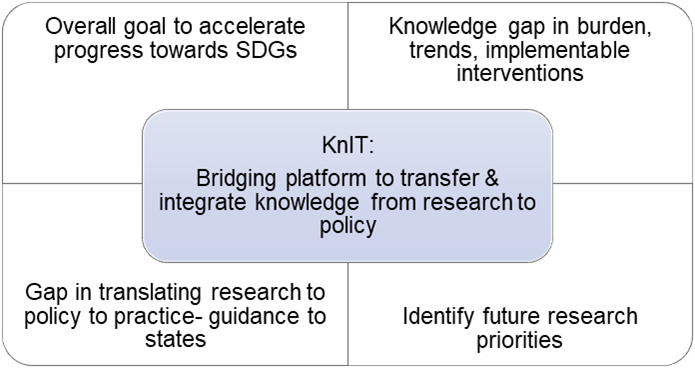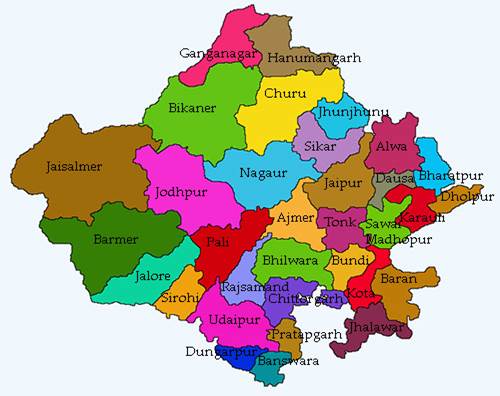Knowledge Integration and Economic Analysis
Economic evaluation is the comparative analysis of alternative courses of action in terms of both their costs and consequences. It involves two main areas, first, the costs and consequences of programmes or interventions and, second, choices which have to be made in allocation of resources. The purpose is to identify the best course of action, based on the evidence available.
Knowledge Integration and Translational Platform – Nutrition Domain Center
The overall interest is in the domain of maternal and child nutrition with specific interest in thriving of children for attainment of their full potential for growth and development. The priority areas have been chosen with the first 1000 days of life in mind, starting with antenatal period and till 2 years of age. The current priority areas include antenatal care, growth and nutrition in early life, low birth weight, anemia.

Work done under Priority Areas of KnIT Nutrition
ANTENATAL CARE
Utilisation of Full Antenatal Care and Associated Factors in India: Analysis from National Family and Health Survey 4


Gestational Weight Gain in Pregnancy and its Association with Birth Outcomes: Analysis from an Intervention Cohort in Delhi, India

Burden of Severe Acute Malnutrition in the first 6 months of life and its associated risk factors: analysis from National Family and Health Survey 4


Predictive Ability of Different Anthropometric Indicators for Mortality in the First Six Months of Life: Secondary Data Analysis

The burden of undernutrition in the first six months of life is high. Diagnostic criteria for undernutrition in this age group have been identified as a priority area of research by WHO. We compared WLZ with WAZ and LAZ measured at six weeks of age for predicting deaths between 6 weeks and 6 months of age, using data from an individually randomized trial conducted in the urban slums of Delhi, India. The specificity ranged between 85.9 to 95.9% for all three anthropometric indicators. However, the sensitivity was highest for WAZ < -3 (64.6 %) vs LAZ<-3 (39.1%), and WLZ<-3 (25.0%). WAZ <-3 had highest AUC of 0.75, adjusted relative risk (aRR 10.6) and the population attributable fraction (57.9%) out of the three indicators. Our findings suggest that WAZ<-3 at 6 weeks of age was a better predictor of death between 6 weeks to 6 months of life and that it should be considered to diagnose SAM in this age group. Status: The manuscript has been published in BMC Pediatrics journal.
The major factors associated with DSMR reduction in under-fives during 1980 to 2015, were increase in ORS use, reduction in stunting prevalence, improved sanitation, changes in age-appropriate breastfeeding practices, increase in the vitamin-A supplementation and persistent diarrhoea treatment. While it is crucial to improve the coverage and equity in ORS use, an integrated approach to promote nutrition, WASH and direct diarrhoea interventions is likely to yield the highest impact on reducing the remaining diarrheal deaths in under-five children.

Secondary Analysis to Examine Linear Growth of Low Birth Weight Children Born to Short Stature Mothers in India

We found that infants born to short mothers had around two-fold higher odds of stunting and lower attained length‐for‐age Z scores compared to infants of mothers with height ≥150 cm, at all ages of assessment. Linear growth velocity was significantly lower in infants of short mothers particularly in the first 6 months of life. We conclude that LBW infants born to short mothers are at a higher risk of stunting and have slower postnatal growth velocity resulting in lower attained length‐for‐age Z scores in infancy
Systematic Review and Meta-analysis to Estimate the Cognitive and Motor Deficits Among Low Birth Weight Children in South Asia
We found that in south Asia, children born LBW, especially with < 2000 g birth weight, have substantial cognitive and motor impairment compared to children with NBW. Early child development interventions should lay emphasis to children born LBW


Interventions did not decrease or increase the risk of cognitive and motor impairment, cerebral palsy, visual, and hearing impairment. Quality of evidence was “low” to “very low.” Limited evidence from RCTs does not demonstrate a difference in neurodevelopmental outcomes between prebiotic/probiotic treated and untreated control groups.
Technical Consultation of the National Expert Group on Prevention and Treatment of Iron Deficiency Anaemia

The relation between iron intake and the odds of anemia was weak (OR: 0.992; 95% CI: 0.991, 0.994); increasing iron intake by 10 mg/d reduced the odds of anemia by 8%. Providing fortified iron alone may not result in substantial anemia reduction among WRA in India and could have variable benefits and risks across states. Geographically nuanced dietary strategies that include limited fortification and the intake of other beneficial nutrients should be carefully considered.

Knowledge Integration and Translational Platform – State Support

KnIT also supported the state through a consultative process to arrive at a consensus strategy for scale up of KMC in all districts of Haryana. The consultation would review pilot district-based projects on KMC by WHO and other institutions in Sonipat, Haryana, Raebareli, Uttar Pradesh and Koppel, Karnataka. The lessons drawn would relate to need for change in national and state strategy, and more specifically suggest a model for rapid scale up of KMC in districts other than Sonipat. The consultation was organized by KnIT together with WHO, SAS, Community Empowerment Lab, Karnataka Trust and state and central government representatives.
Himachal Pradesh has experienced in a decline in infant mortality at a study rate but acceleration will require faster reduction in neonatal mortality particularly in those districts which are difficult to access on account of hilly terrain, road access, extreme weather and challenges for human resource for health care on a sustainable basis. The data sources for this analysis are both secondary and primary. The secondary data sources include HMIS, district based NFHS-4 data and baseline survey in one block of district Sirmaur. In addition, reports of assessments available in knowledge and skills of ASHA workers, ANMs, nurses and physician were reviewed. The quality of neonatal care in sub-centres, PHCs, CHCs and district hospitals were assessed.


An Indepth Analysis to Understand the Burden of Wasting and Severe Wasting and the Associated Factors Among Under-five Children in India: A Collaboration between UNICEF and CHRD-SAS
India-specific data on the patterns of growth for high-risk groups like low birth weight, preterm and small for gestational age are of poor quality and/or scarce. The 2006 WHO Growth standards used in national programs for growth monitoring does not include all these high-risk groups and there is ambiguity regarding the most appropriate indicator for identifying infants under 6 months of age who are at risk of growth faltering and adverse outcomes like mortality, morbidity, and continued malnutrition. High quality evidence on the efficacy of exclusive breastfeeding and lactational support for prevention of undernutrition in the first 6 months of life is needed.
CHRD-SAS has a rich repository of data from previous and ongoing studies and we are also a partner in the Knowledge Integration (Ki) initiative which is a repository of health research data from across the globe. We will use data from intervention trials (Women and Infant Integrated Growth Study, WINGS), cohort studies on acute malnutrition (Ki) and cross-sectional studies (Ki and Comprehensive National Nutrition Survey, CNNS) and surveys to estimate the prevalence of wasting and severe wasting in the first 6 months and the first year of life. Estimates will be generated overall and by high risk groups.
We believe that the results from this analysis will be helpful in identifying indicators for growth faltering and in assessing growth that is possible and can be targeted and monitored through program interventions for high risk groups. Understanding the risk periods for growth faltering, its duration and associated factors may provide a window for targeted early intervention and preventing undernutrition. Status: The report based on the analysis is completed and the manuscript titled “Prevalence of wasting and its associated factors among children under five years of age in India: findings from the Comprehensive National Nutrition Survey” will be submitted for peer review soon.
Technical review for “Effectiveness of Community-based Treatment Programs to Treat Children aged 6-59 Months with Uncomplicated Severe Acute Malnutrition using Alternative Energy Dense Foods: A Multicentric Prospective Longitudinal Follow Up Study”
The overall goal is to work collaboratively with the Centre of excellence Kalawati Saran’s team to provide an independent technical review of the design, implementation, analysis and interpretation of the initiative to assess the impact of the mainstreaming CMAM study in India.
This study is a partnership between Children’s Investment Fund Foundation (CIFF), UNICEF and Kalawati Saran’s Children’s Hospital.
The aim of the study is to estimate the cure rates for CMAM programs using locally available options for energy dense food through a quasi-experimental design in 5 states.4 states (Telengana, MP, Chattisgarh and Odisha) have already started using CMAM protocols or are planning to pilot the use of energy dense foods in their CMAM programs. Jharkhand will be the control state with a basic protocol.
Results from the study will be shared to help other states adopt the guidelines and energy dense foods which were effective. Status: Ongoing
The following analyses are being conducted to assess the impact of ciKMC on household poverty and expenditure.
The equity impact of ciKMC on survival during the first 28 and first 180 days of life across axes of disadvantage like gender, caste, socioeconomic status etc.
The impact on ciKMC on catastrophic out-of-pocket expenditure and impoverishment due to cost of care seeking
Better estimates on the efficacy of ciKMC on household out-of-pocket expenses will allow for a higher precision when estimating the economic return to investment in this intervention – which is particularly important in resource poor settings.
The availability of the HBGDKi datasets comprising of more than 180 studies from across the world including 30 datasets from India provides and excellent opportunity to apply advanced analytical and machine learning techniques for exploring these datasets and answering questions in the domain of maternal and child health and nutrition.
We utilized the opportunity available through Grand Challenges Exploration India, to collaborate with the Indian Institute of Technology, Delhi and St. John’s Research Institute, Banglore to apply for this competitive call with the aim of answering questions in the priority areas for KnIT.
The Indian Institute of Technology Delhi and KnIT-Nu project aims at exploring risk factors of adverse maternal and child health outcomes using machine learning and other advanced data analytical approaches. The St. John’s Research Institute and KnIT-Nu project aims to use a data science approach to develop growth cut-offs for graded care of malnutrition.
